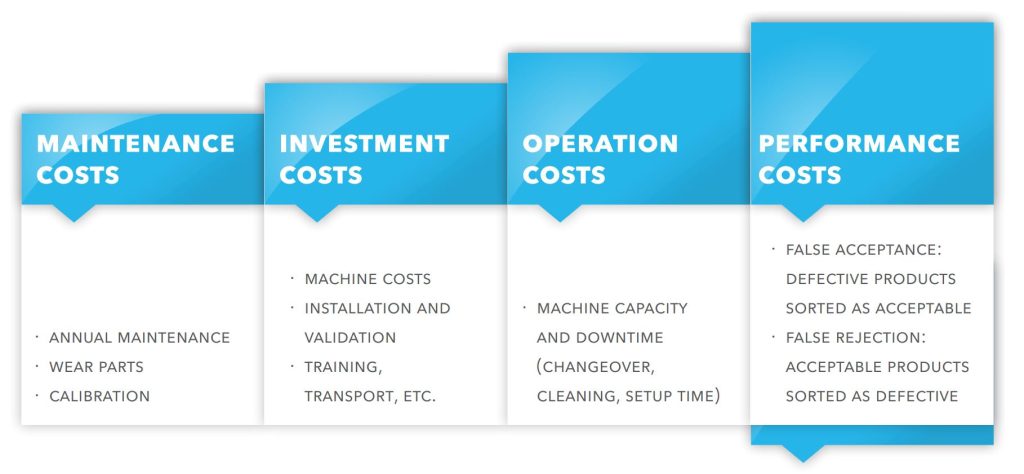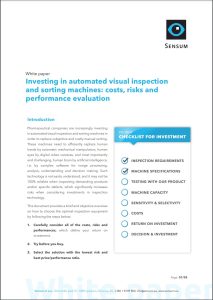Investing in automated visual inspection and sorting machines: costs, risks and performance evaluation

Introduction

Pharmaceutical companies are increasingly investing in automated visual inspection and sorting machines in order to replace subjective and costly manual sorting. These machines need to efficiently replace human hands by automatic mechanical manipulators, human eyes by digital video cameras, and most importantly and challenging, human brain by artificial intelligence, i.e. by complex software for image processing, analysis, understanding and decision making. Such technology is not easily understood, and it may not be 100% reliable when inspecting demanding products and/or specific defects, which significantly increases risks when considering investments in inspection technology.
This document provides a brief and objective overview on how to choose the optimal inspection equipment by following the steps below:
- Carefully consider all of the costs, risks and performances, which define your return on investment.
- Try before you buy.
- Select the solution with the lowest risk and best price/performance ratio.
Costs
Total life-cycle costs of an automated visual inspection machine may more than double the quoted price of the inspection machinery. The costs consist of investment and maintenance costs, which are straightforward, and also of operation and performance costs, which are more hidden.
The first of the hidden costs are operation costs. These costs are high, if the machine does not operate at declared capacity or has long downtimes due to tedious cleaning and changeover. The second and the most often overlooked hidden costs are performance costs, which originate from sub-optimal inspection quality. Inspection quality is the capability of the machine to correctly detect and sort the inspected products. Both, false rejection and false acceptance depend on product properties and on the design of the inspection machine, where inspection needs to be sensitive to specific defects and needs to tolerate the variations of acceptable products. High quality inspection with minimal false rejection and false acceptance is achieved with a reliable detection of not only straightforward defects (e.g. black dots, shape defects) but all defects, that can be critical, influencing the functionality of the product (e.g. lamination tendency or coating defects) or defects influencing the product identification (e.g. engraving or printing legibility), etc.

False rejection
False rejection are all acceptable products sorted as defective.
This is a direct and easily measureable cost, as the acceptable
products are falsely rejected rather than accepted and sold.
False acceptance
False acceptance are all defective products sorted as
acceptable. This is an indirect cost, which increases the risk of
batch recalls and company reputation.
Risks
Risks related to automated visual inspection originate from a poor machine design and poor inspection quality! There are four risks with considerable consequences that should be acknowledged.

See the full White Paper “Investing in automated visual inspection and sorting machines: costs, risks and performance evaluation” here:
(click the picture to download the White Paper)
Source: Sensum, White Paper “Investing in automated visual inspection and sorting machines: costs, risks and performance evaluation”
Interested in more information about Sensum Spine Fibo or another Sensum product?


